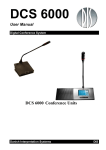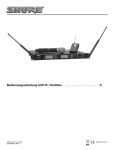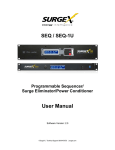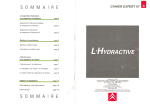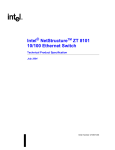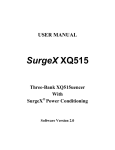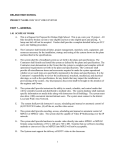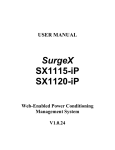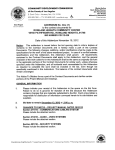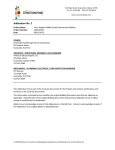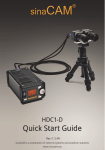Download 141-10-ifb attachment f - Dawson County, Georgia
Transcript
Dawson County Dawson County Courthouse NOVEMBER 24, 2010 EDI – 100027GA SECTION 27 61 00 AUDIO-VISUAL SYSTEM PART 1 - GENERAL 1.1 GENERAL A. Contractor is responsible for pricing all accessories, power supplies, mounts and other miscellaneous equipment required to form a complete system. Unless otherwise noted in this Part, equipment quantities shall be as indicated on the Drawings. B. All products within a given category for a particular system must be by the same manufacturer unless otherwise noted. Examples: All ceiling speakers within a given room; All control system products. C. Product specifications as outlined below are to establish the minimum functionality requirements of the components to be used in this project. The feature-set of the specified product shall be considered the minimum feature-set required, not withstanding any summary description of features given within this section. D. Many products listed herein are particularly prone to rapid technological evolution. The Contractor shall be responsible for ensuring that the products installed are the latest models and incorporate the latest performance improvements available within the same cost as the specified product. For any deviations from the specified model number and manufacturer necessary to meet this requirement, the Contractor must still secure approval using the substitution procedure outlined under Product Substitutions under the Submittals section. PART 2 - PRODUCTS 2.1 AUDIO A. Mini Amplifier: 1. Acceptable: Stewart CVA 25-1 2. Provide mounting hardware to mount above projector on pole or shelf B. Amplifier – Multi Channel: 1. Acceptable: Crown CTS series C. Audio DSP (Courtrooms) 1. Acceptable: Clearone Converge SR1212. 2. Configuration note: Contractor may provide the above DSP’s with integrated amplifier channels provided the integrated amplifiers fulfill all requirements of the drawings and specifications. 3. Configuration note: Provide multiple units networked together as required to meet the quantity of inputs and outputs shown on the drawings. November 24, 2010 AUDIO-VISUAL SYSTEM 27 61 00 - 1 Dawson County Dawson County Courthouse NOVEMBER 24, 2010 EDI – 100027GA D. Audio DSP (all other rooms) 1. Acceptable: Clearone Interact Pro Series. E. Table Top Microphone (with logic output/input): 1. Acceptable: Clock Audio C33E-HALO/RF with S157EDI table top stand. 2. Configuration note: LED on base shall be disabled. HALO LED will indicate microphone state. See Audio-Visual System Description document for additional configuration information. 3. Coordinate installation location with the furniture provider and owner. F. Table Top Microphone (with no logic output/input): 1. Acceptable: Clock Audio C33E/RF with S133 table top stand. 2. Coordinate installation location with the furniture provider and owner. G. Wireless Microphone System, Secure: 1. Acceptable: TELEX SAFE-1000H/L combo system with: a. SAFE 1000 UHF receiver b. SAFE HD EV 767a NDYM handheld transmitter c. SAFE WT bodypack transmitter d. ELM-22S omni lapel mic e. Rack mount hardware f. 2 ¼ wave antennas g. Power supply Acceptable: TELEX SAFE-WT Bodypack Transmitter 2. H. Wireless Microphone System: 1. Acceptable: Shure ULXP4 Receiver (single channel) 2. Acceptable: Shure ULX1 Body Pack Transmitter 3. Acceptable: Shure WL185 cardioid lavalier microphone with lapel clip a. Qty: One (1) for each Body Pack Transmitter 4. Acceptable: Shure ULX2 Wireless Handheld Transmitter with SM58 microphone head. I. Mask Microphone: 1. Acceptable: Martel MMXLR Mini Mask J. Ceiling Microphone: 1. Acceptable: Clock Audio C007E K. Assistive Listening/Translation System (ALS), IR: 1. Acceptable: Listen Technologies: a. LT-82 transmitter with LA-326 rack mount hardware b. LA-140 radiator with wall mount hardware c. LR-44 lanyard receiver. 1) Qty: Two (2) receivers per courtroom. d. LA-304 notification signage kit 1) Qty: One (1) kit per courtroom. Turn over to owner for installation. L. Assistive Listening System (ALS), RF: 1. Acceptable: Listen Technologies November 24, 2010 AUDIO-VISUAL SYSTEM 27 61 00 - 2 Dawson County Dawson County Courthouse a. b. c. NOVEMBER 24, 2010 EDI – 100027GA LT-800 Transmitter LR-400 receiver w/ ear speaker. 1) Qty: Two (2) receivers per transmitter. LA-304 notification signage kit 1) Qty: One (1) kit per room with ALS. Turn over to owner for installation. M. In-Ear System (RF): 1. Acceptable: Shure PSM200 a. P2T transmixer b. P2R Bodypack receiver 1) Qty: one (1) c. SE115 sound isolating earphones, clear 1) Qty: one (1) d. SE115 sound isolating earphones, black 1) Qty: one (1) N. Ceiling Speaker, 70V and 6ohm: 1. Acceptable: Tannoy CVS-6 2. Include Backcan, grille, and applicable ceiling tile or gypsum mounting hardware. Coordinate grille color with architect/interiors prior to ordering. O. Audio Recorder: 1. Acceptable: Denon PMD 661 2. Fabricate/provide 8’ length splitter cable to split mono XLR plate output to both the left and right XLR inputs of the recorder (mono across two channels.) P. Balanced to Unbalanced Converter: 1. Acceptable: RDL FP-BUC2; Extron BUC 102 2. Provide this device between any balanced to unbalanced audio connections, unless indicated otherwise on the drawings. The cable connection length between the unit and the unbalanced device shall not exceed 36”. Q. Unbalanced to Balanced Converter: 1. Acceptable: RDL AFC1M; Extron BUC 102 2. Provide this device between any unbalanced to balanced audio connections, unless indicated otherwise on the drawings. The cable connection length between the unit and the unbalanced device shall not exceed 36”. R. Audio summing adapter (SUM): 1. Acceptable: Extron ASA series, Radio Design Labs AV-DC4. 2. Provide this device for any connection between a stereo output and mono input. Install device closest to the stereo output. 2.2 A. VIDEO/GRAPHICS DISPLAY Projection Screen: See separate projection screen spec. Screens provided and installed by AV Contractor in close coordination with General Contractor. November 24, 2010 AUDIO-VISUAL SYSTEM 27 61 00 - 3 Dawson County Dawson County Courthouse NOVEMBER 24, 2010 EDI – 100027GA B. Projector, XGA, 4000L, 1 chip DLP 1. Acceptable: Panasonic PT-F300U. 2. Provide projector w/ zoom lens required to meet throw distances and image sizes on drawings. Using measurements made on-site, confirm projector/lens combination will provide specified image size from installed projector location prior to ordering. C. Ceiling Mount For Projectors: 1. Pipe and mount assembly compatible with the specified projector and with the specified ceiling box. 2. Acceptable manufacturers: Chief, Display Devices, Peerless. D. Ceiling Box 1. Acceptable: FSR CB-22SP E. Portable Projector, XGA, 3000L, LCD 1. Acceptable: Panasonic PTLB78VU. Include power supply and cable. Provide VGA 15 pin cable with 1/8” audio. 2. Provide unit price for this device. Owner to determine quantity after contract award. F. Monitor, 32” Diagonal 1. Acceptable: Sharp LC32SB28UT G. Monitor, 42” Diagonal 1. Acceptable: Sharp LC42SB48UT H. Monitor, 60” Diagonal 1. Acceptable: Sharp LC60E77UM I. Monitor, 65” Diagonal: 1. Acceptable: Sharp LC65E77UM J. Wall mount for Monitor: 1. Tilt adjust wall-mount bracket, with lockable adjustments. Compatible with specified monitor size per manufacturer’s recommendations. 2. Acceptable: Chief MTM, LTM and XTM series mounts. K. Recess Monitor: 1. 19” diagonal, LCD flat panel display. 2. Acceptable: NEC AccuSync AS191-BK. 3. Coordinate installation with architect and furniture provider. Provide separate stand/mount as required for recessed application. L. Stand Monitor: 1. 17” diagonal, LCD flat panel display. 2. Acceptable: NEC AccuSync AS171-BK. M. Jury Monitor 1. 19” diagonal, LCD flat panel display. 2. Acceptable: NEC AccuSync AS191-BK. November 24, 2010 AUDIO-VISUAL SYSTEM 27 61 00 - 4 Dawson County Dawson County Courthouse NOVEMBER 24, 2010 EDI – 100027GA N. Annotation Monitor 1. 17” touch sensitive LCD flat panel display with stand. 2. Acceptable: ELO 1715L O. Annotation Processor 1. Acceptable: Pointmaker PVI-83-DU-COMM-4 2. Configuration note: Provide and install additional comm ports as indicated on drawings P. Annotation Pen Display: 1. Acceptable: Smart Sympodium ID370 Q. Fold-Down Table Top Stand 1. Chief FSB-018BLK 2. Provide and install for stand monitor at each judge and witness location. R. Document Camera: 1. Acceptable: Wolfvision VZ-9PLUS-3. S. Dome Camera: 1. Acceptable: Bosch LTC1421/20 T. DVD Player: 1. Acceptable: Denon DN-V310 2. Provide rack mount - Middle Atlantic Products RSH-C. U. DVD/VHS Combo Recorder: 1. Acceptable: JVC DR-MV150B V. AV Tuner: 1. Acceptable: Contemporary Research 232-ATSC+HDTV Tuner. Provide rack mounting hardware. 2.3 SWITCHING AND ROUTING A. UTP Switcher: 1. Acceptable: Extron MTP SW6 B. Presentation Matrix Switcher: 1. Acceptable: Extron MPX 866 A C. RGBHV TX (with or without audio): 1. Acceptable: Extron MTP T 15HD A D. RGBHV RX (with or without audio): 1. Acceptable: Extron MTP RL 15HD A SEQ E. RS232 TX/RX (for use with annotation processor only): 1. Acceptable: Pointmaker DTX-DRVR5-232 pair. November 24, 2010 AUDIO-VISUAL SYSTEM 27 61 00 - 5 Dawson County Dawson County Courthouse NOVEMBER 24, 2010 EDI – 100027GA F. Converter: 1. Acceptable: Extron CVC 300 G. Muting DA: 1. Acceptable: Extron DA6 RGBHV H. DA: 1. Acceptable: Extron DA4 RGBHV (4 input) 2. Acceptable: Extron DA6 RGBHV (6 input) I. Line Driver 1. Acceptable: Extron Extender Series. 2. Installation note: Where line driver is shown installed in a floor box, confirm that installed floor box will accommodate the line driver and all other connectors shown. Do this prior to ordering. J. Scaling Switcher: 1. Acceptable (no audio switching): Extron DVS 304 DVI 2. Acceptable (with audio switching): Extron DVS 304 DVI A 2.4 DELEGATE SYSTEM A. DS Staff Unit 1. Acceptable: DCS DC 6120P B. DS Del Unit 1. Acceptable: DCS DM 6680P C. DS Chair Unit 1. Acceptable: DCS DC 6990P D. DS Buss 1. Acceptable: DCS JB 6002/6004 E. Plug-In Mics for Units: 1. Acceptable: DCS GM 6523 F. DS Processor 1. Acceptable: DCS CU 6005 G. Conference Software Package 1. Acceptable : DCS6000 Conference Software Package H. Voting Feature License for up to 50 units 1. Acceptable: DCS FL 6000 4A 2.5 A. CONTROL Touch Panel: November 24, 2010 AUDIO-VISUAL SYSTEM 27 61 00 - 6 Dawson County Dawson County Courthouse 1. 2. NOVEMBER 24, 2010 EDI – 100027GA Acceptable: Crestron TPS-4L with mounting back box. Coordinate installation in furniture surfaces with furniture provider. B. Table Box with Lid Touch Panel: 1. Crestron C2N-FT-TPS4 2. Coordinate installation in furniture surfaces with furniture provider. C. Table Box with Lid Key-Pad: 1. Crestron C2N-FTB-D 2. Coordinate installation in furniture surfaces with furniture provider. D. Key-Pad: 1. Crestron CNX-B12 2. Coordinate installation in furniture surfaces with furniture provider. E. Control System Processor: 1. Acceptable: Crestron 2-series control processor, configured as shown on drawings. 2. Installation note: Coordinate control processor selection with mounting space available when mounting in ceiling box or in furniture (no rack). F. Software Modules and licenses – configured by AV contractor: 1. Acceptable: Crestron RoomView Server Edition Room Management Software: Provide licenses as required to cover all rooms with AV systems. 2. Configuration and coordination: a. Provide minimum requirements to Owner for server to run room management software. Owner shall provide server. Coordinate directly with and assist Owner to set-up and configure server. b. Coordinate with Owner to determine features and functions required for room management software. Set-up and configure room management software per Owner requirements. 2.6 Miscellaneous A. Evidence Presentation Cart: 1. Acceptable: Marshall Furniture MFI #23969 TF. B. Furniture Equipment Rack Surge Protection 1. Acceptable: SurgeX SX1120RT. C. Table Box (no touch panel or button panel): 1. Extron Cable Cubby 300S. 2. Coordinate installation in furniture surfaces with furniture provider. D. AV Rack, Wall Mounted Swing Rack: 1. Acceptable: Middle Atlantic DWR Series 2. Coordination: Coordinate rack size with enclosed equipment. 3. Coordination: Coordinate rack depth and swing with installation location using measurements taken on-site prior to ordering. November 24, 2010 AUDIO-VISUAL SYSTEM 27 61 00 - 7 Dawson County Dawson County Courthouse 4. NOVEMBER 24, 2010 EDI – 100027GA Install the following products in rack provided by same manufacturer or as specified: a. HTX security screws w/ nylon isolation bushings. b. SB(X) textured blank panels. c. RSH-4C Custom mounts for components without rack mount kits. d. S(X) security covers for devices with front panel controls that cannot be locked out. E. AV Rack, Slide-Out, Mounted in Millwork: 1. Acceptable: Middle Atlantic SRSR series rack. 2. Coordination: Coordinate height with rough opening in millwork. 3. Install the following products in rack provided by same manufacturer or as specified: a. HTX security screws w/ nylon isolation bushings. b. SB(X) textured blank panels. c. RSH-4C Custom mounts for components without rack mount kits. d. S(X) security covers for devices with front panel controls that cannot be locked out. F. Equipment Rack Power Sequencer for wall mounted AV rack: 1. Acceptable: Surge-X SEQ. If additional outlets are required, provide Surge-X SX1120-RT remote units as required. G. Rack Surge Protection for slide-out rack: 1. Acceptable: Surge-X SX1120RT H. Projector/Display Surge Protection 1. Acceptable: SurgeX SX20-NE. I. Equipment Rack Power Sequencer: 1. Acceptable: Surge-X SEQ. If additional outlets are required, provide Surge-X SX1120-RT remote units as required. J. Projector Surge Protection 1. Acceptable: SurgeX SX20-NE. K. Cabinet Cooler Fan: 1. Acceptable: Middle Atlantic CAB-COOL 2. Provide in evidence presentation carts and other furniture as required to maintain acceptable equipment temperature. Coordinate location with furniture provider. L. Floor Box Mounted Device Plates: Manufacturer standard or custom insert plates with engraved text & graphics 1. to fit installed floor boxes. Submit detailed drawings of panels prior to ordering. 2. Acceptable: ProCo, RCI, FSR, custom by Contractor. M. Poke-Thru Mounted Device Plates: 1. Acceptable: Extron MAAP 2. Provide plates with connectors or pass-thru as indicated on drawings. November 24, 2010 AUDIO-VISUAL SYSTEM 27 61 00 - 8 Dawson County Dawson County Courthouse N. 2.7 NOVEMBER 24, 2010 EDI – 100027GA Wall and Rack Mounted Device Plates: 1. Custom or standard NEMA plates or EIA 19” panels with engraved text & graphics. Submit detailed drawings of panels prior to ordering. 2. Acceptable: ProCo, RCI, FSR, custom by Contractor. Cable and Connectors A. All cable not installed inside racks or conduit shall be plenum rated. B. Line Level Audio and Microphone Cable, Plenum Rated: 1. Plenum rated line level audio and microphone cable. Shielded, twisted pair. Minimum 22AWG, stranded conductors and 24AWG drain wire with overall jacket. 2. Acceptable: West Penn 25291 or comparable by Belden or Gepco. C. Line Level Audio and Microphone Cable: 1. For use inside racks and conduit. Shielded, twisted pair. Minimum 22AWG, stranded conductors and 24AWG drain wire with overall jacket. 2. Acceptable: West Penn 291 or comparable by Belden or Gepco. D. Microphone Cable: 1. Microphone cable for use on exposed surfaces such as tables and desktops. Shielded, twisted pair. Flexible overall jacket. 2. Acceptable: Canare L4E6S or comparable by Belden, Gepco. E. Composite video Cable: 1. For use inside racks and conduit. RG-59/U type 20 AWG solid center conductor with 95% bare copper braid and nominal attenuation of .9 dB/100 ft at 10 MHz. 2. Acceptable: West Penn 815 or comparable by Belden or Canare. F. Composite video Cable, Plenum Rated: 1. RG-59/U type 20 AWG solid center conductor with 95% bare copper braid and nominal attenuation of .9 dB/100 ft at 10 MHz. 2. Acceptable: West Penn 25815 or comparable by Belden or Canare. G. Composite video Cable: 1. For use inside racks and conduit. RG-6/U type 18 AWG solid center conductor with 95% bare copper braid and nominal attenuation of .7 dB/100 ft at 10 MHz. 2. Acceptable: West Penn 806 or comparable by Belden or Canare. H. Composite video Cable, Plenum Rated: 1. RG-6/U type 18 AWG solid center conductor with 95% bare copper braid and nominal attenuation of .7 dB/100 ft at 10 MHz. 2. Acceptable: West Penn 25806 or comparable by Belden or Canare. I. VGA, RGB, S-Video and component video YUV (YPbPr) cable: 1. For use inside racks and conduit. Shall be up to six (6) 26 AWG stranded center conductors (quantity determined by signal type) individual and overall November 24, 2010 AUDIO-VISUAL SYSTEM 27 61 00 - 9 Dawson County Dawson County Courthouse 2. NOVEMBER 24, 2010 EDI – 100027GA sheath with resistance of 41 ohm/1000 ft., capacitance of 18 pF/ft, and 78% velocity of propagation. Audio-Visual Contractor may combine S-video and component video on one multi-conductor coax assembly cable. Acceptable: Extron MHR series or comparable by Belden or Canare. J. VGA, RGB, S-Video and component video YUV (YPbPr) cable, Plenum Rated: 1. Shall be up to six (6) 26 AWG stranded center conductors (quantity determined by signal type) individual and overall sheath with resistance of 41 ohm/1000 ft., capacitance of 18 pF/ft, and 78% velocity of propagation. Audio-Visual Contractor may combine S-video and component video on one multi-conductor coax assembly cable. 2. Acceptable: Extron MHR-P series or comparable by Belden or Canare. K. Speaker Level Audio Cable (70v): 1. For use inside racks and conduit. For use with 70 volt speaker circuits. 18AWG stranded pair, minimum. 2. Acceptable: West Penn 224 or comparable by Belden or Canare. L. Speaker Level Audio Cable, Plenum Rated (70v): 1. For use with 70 volt speaker circuits. 18AWG stranded pair, minimum. 2. Acceptable: West Penn 25224 or comparable by Belden or Canare. M. Speaker Level Audio Cable: 1. For use inside racks and conduit. For use with 8/4/2 Ohm program audio speaker circuits. 14AWG stranded pair, minimum. 2. Acceptable: West Penn 295 or comparable by Belden or Canare. N. Speaker Level Audio Cable, Plenum Rated: 1. For use with 8/4/2 Ohm program audio speaker circuits. 14AWG stranded pair, minimum. 2. Acceptable: West Penn 25295 or comparable by Belden or Canare O. CAT 5e (UTP RJ-45 connections): 1. Shall be 8-conductor 24 AWG unshielded twisted pair, minimum. Cable shall be Category-5e rated and tested to 100Mhz. Provide Plenum rated as required. 2. Acceptable: Extron, Belden, Commscope, General Cable, Superior Essex or NordX. Patch cables by Panduit or approved alternate. P. Control bus cable (non-UTP RJ-45 connections): 1. Shall be 2-conductor 18 AWG, 2-conductor shielded 22 AWG, minimum. 2. Acceptable: Liberty Wire & Cable Cresnet or comparable by Belden, West Penn or Gepco. Q. Connectors: 1. All connectors provided shall meet or exceed the published ANSI or manufacturer requirements for the signal type(s) being carried. 2. Acceptable: By contractor. Provide cut sheets for typical connectors with shop drawing submittals. November 24, 2010 AUDIO-VISUAL SYSTEM 27 61 00 - 10 Dawson County Dawson County Courthouse NOVEMBER 24, 2010 EDI – 100027GA PART 3 - EXECUTION 3.1 A. 3.2 A. GENERAL The system shall be tested for proper operation to the satisfaction of Owner. The speaker output level of all areas shall meet the requirements of The Owner. Volume level and/or speaker tap changes shall be made to meet these requirements. INSTALLATION General 1. Execute work in accordance with State and local codes, regulations and ordinances. 2. Install work neatly, plumb and square and in a manner consistent with standard industry practice. Coordinate on-site installation with other trades, and carefully protect work from dust, paint and moisture as dictated by site conditions. The Contractor will be fully responsible for protection of his work during the construction phase up until final acceptance by the owner. 3. Install equipment according to manufacturer’s recommendations. Provide any hardware, adaptors, brackets, rack mount kits or other accessories recommended by manufacturer for correct assembly and installation. 4. Provide any conduit sleeves through walls and above hard ceilings as required to route cable. Provide fireproofing in sleeves as required by local code. 5. Provide any additional cutting, drilling, fitting or patching required to complete the Work or to make its parts fit together properly. This includes but is not limited to: Finished openings in ceilings for screens and speakers; finished openings in walls for speakers and flush-mount equipment cabinets; sheet-rock rings in walls for connector plates; cable sleeves through fire-rated walls. 6. The Contractor shall not damage or endanger a portion of the Work or fully or partially completed construction of the Owner or separate contractors by cutting, patching or otherwise altering such construction, or by excavation except with written consent of the Owner and of any separate contractor. 7. Secure equipment firmly in place, including control panels, receptacles, speakers, racks, cables, etc. a. All supports, mounts, fasteners, attachments and attachment points shall support their loads with a safety factor of at least 5:1 for static loads and 8:1 for dynamic loads. b. Do not impose the weight of equipment or fixtures on supports provided for other trades or systems. c. Any suspended equipment or associated hardware must be certified by the manufacturer for overhead suspension. d. The Contractor is responsible for means and methods in the design, fabrication, installation and certification of any supports, mounts, fasteners and attachments. 8. Locate overhead ceiling-mounted loudspeakers as shown on drawings, with minor changes not to exceed 12” in any direction. November 24, 2010 AUDIO-VISUAL SYSTEM 27 61 00 - 11 Dawson County Dawson County Courthouse NOVEMBER 24, 2010 EDI – 100027GA a. 9. 10. Mount transformers securely to speaker brackets or enclosures using screws. Adjust torsion springs as needed to securely support speaker assembly. b. Speaker back boxes that are separate assemblies shall be completely filled with fiberglass insulation. c. Seal cone speakers to their enclosures to prevent air passing from one side of the speaker to the other. Finishes for any exposed work such as plates, racks, panels, speakers, monitors projectors, etc. shall be approved by the Architect or Owner. Coordinate cover plates with field conditions. Size and install cover plates as necessary to hide joints between back boxes and surrounding wall. Where cover plates are not fitted with connectors, provide grommeted holes in size and quantity required. Do not allow cable to leave or enter boxes without cover plates installed. B. Equipment Racks 1. Mount equipment in racks and fully wire and test the system at the Contractor's shop facilities. Limit work on-site to termination, mounting and final system checkout. The Contractor and Owner reserve the right to visit the Contractor's facilities, with 5 business days notice, and to inspect work in progress and storage of materials. 2. Fill unused equipment mounting spaces with blank panels or vent panels. Match color to equipment racks. 3. In the event there is not a lockable rack door, provide individual security covers for all devices not requiring routine operator control. 4. Provide vent panels and cooling fans as required for the operation of equipment within the manufacturers' specified temperature limits. Provide adequate ventilation space between equipment for cooling. Follow manufacturer’s recommendations regarding ventilation space between amplifiers. 5. Provide insulated connections of the electrical raceway to equipment racks. 6. Provide continuous raceway with no more than 40% fill between wire troughs and equipment racks for all non-plenum-rated cable. Separate circuits as described in elsewhere in this section. C. Wiring Practice 1. Execute all wiring in strict adherence to the National Electrical Code, applicable local building codes and standard industry practices. 2. All cable not installed inside racks or conduit shall be plenum rated. 3. Wiring shall be classified according to the following low voltage signal types: a. Balanced microphone level audio (below -20dBm) b. Balanced line level audio (-20dBm to +30dBm) Loudspeaker level audio (above +30dBm) c. d. Video e. Low voltage DC control or power (less than 48VDC) f. Intercom with low voltage DC power 4. Where raceway is to be EMT (conduit), wiring of differing classifications shall be run in separate conduit. Where raceway is to be an enclosure (rack, wire trough, utility box) wiring of differing classifications which share the same enclosure shall be separated by at least four (4) inches. Where Wiring of November 24, 2010 AUDIO-VISUAL SYSTEM 27 61 00 - 12 Dawson County Dawson County Courthouse 5. 6. 7. 8. 9. 10. 11. 12. 13. 14. 15. NOVEMBER 24, 2010 EDI – 100027GA differing classifications must cross, they shall cross perpendicular to one another. Do not splice wiring anywhere along the entire length of the run. Make sure cables are fully insulated from each other and from the raceway for the entire length of the run. Do not pull wire through any enclosure where a change of raceway alignment or direction occurs. Do not bend wires to less than radius recommended by manufacturer. Replace the entire length of the run of any wire that is damaged or abraded during installation. There are no acceptable methods of repairing damaged or abraded wiring. Use wire pulling lubricants and pulling tensions as recommended by the manufacturer. Use grommets around cut-outs and knock-outs where conduit or chase nipples are not installed. Do not use tape-based or glue-based cable anchors. Ground shields and drain wires as indicated by the drawings. Field wiring entering equipment racks shall be terminated as follows: a. Provide ample service loops at harness break-outs and at plates, panels and equipment. Loops should be sufficient to allow plates, panels and equipment to be removed for service and inspection. b. Line level and speaker level wiring may be terminated inside the equipment rack using specified terminal blocks (see “Products.”) Provide 15% spare terminals inside each rack. Microphone level wiring may only be terminated at the equipment served. c. If specified terminal blocks are not designed for rack mounting, utilize ¾” plywood or 1/8” thick aluminum plates/blank panels as a mounting surface. Do not mount on the bottom of the rack. d. Employ permanent strain relief for any cable with an outside diameter of 1” or greater. Use only balanced audio circuits unless noted otherwise Make all connections as follows: a. Make all connections using rosin- core solder or mechanical connectors appropriate to the application. b. For crimp-type connections, use only tools that are specified by the manufacturer for the application. c. Use only insulated spade lugs on screw terminals. Spade lugs shall be sized to fit the wire gauge. Do not exceed two lugs per terminal. d. Wire nuts, electrical tape or “Scotch Lock” connections are not acceptable for any application. Serve all cables as follows: Cover the end of the overall jacket with a 1” (minimum) length of a. transparent heat-shrink tubing. Cut unused insulated conductors 2” (minimum) past the heat-shrink, fold back over jacket and secure with cable-tie. Cut unused shield/drain wires 2” (minimum) past the heatshrink and serve as indicated below. b. Cover shield/drain wires with heat-shrink tubing extending back to the overall jacket. Extend tubing ¼” past the end of unused wires, fold back over jacket and secure with cable-tie. c. For each solder-type connection, cover the bare wire and solder connection with heat-shrink tubing. November 24, 2010 AUDIO-VISUAL SYSTEM 27 61 00 - 13 Dawson County Dawson County Courthouse D. 3.3 NOVEMBER 24, 2010 EDI – 100027GA Labeling 1. Clearly, consistently, logically and permanently mark switches, connectors, jacks, relays, receptacles and electronic and other equipment. 2. Engrave and paint fill all receptacle panels using 1/8” (minimum) high lettering and contrasting paint. 3. For rack-mounted equipment, use engraved Lamacoid labels with white 1/8” (minimum) high lettering on black background. Label the front and back of all rack-mounted equipment. 4. Where multiple pieces of equipment reside in the same rack group, clearly and logically label each indicating to which room, channel, receptacle location, etc. they correspond. 5. Permanently label cables at each end, including intra-rack connections. Labels shall be covered by the same, transparent heat-shrink tubing covering the end of the overall jacket. Alternatively, computer generated labels of the type which include a clear protective wrap may be used. 6. Contractor’s name shall appear no more than once on each continuous set of racks. The Contractor’s name shall not appear on wall plates or portable equipment. TEST EQUIPMENT A. The Contractor shall furnish the following test equipment for all testing and adjustments as well as any site visits by the Consultant: 1. Digital Multi-meter 2. Impedance Bridge 3. Sound Level Meter - ANSI Type 2 4. Real-time One-Third Octave Audio Spectrum Analyzer 5. Pink Noise Generator 6. Distortion Analyzer 7. Polarity Tester 8. Programmable Video and Audio Test Generator with SDI/HD-SDI and DVI-D Output: Extron VTG400DVI or equivalent. 9. Video Waveform Monitor 10. Laptop Computer – containing all DSP and control system software B. Depending upon the outcome of any tests, additional troubleshooting may be required by the Contractor. The Contractor shall be prepared to provide the following devices as required for additional troubleshooting: 1. Dual Trace Oscilloscope 2. Sweep/Function Generator 3. Frequency Counter 4. Vectorscope – meeting NTSC standards 3.4 A. PERFORMANCE REQUIREMENTS Control System Programming and Device Configuration: 1. Contractor shall provide all control system programming and touch panel design/button panel engraving. November 24, 2010 AUDIO-VISUAL SYSTEM 27 61 00 - 14 Dawson County Dawson County Courthouse 2. 3. 4. 5. 6. 7. 8. 9. 10. 11. NOVEMBER 24, 2010 EDI – 100027GA Contractor shall configure all devices in the system, including but not limited to: a. Projectors b. Delegate system c. Switchers/Routers d. DSP’s e. Codec’s f. Recording/Lecture Capture devices and software Feature set control of each device and device configuration shall be dictated by Owner requirements. Programming and device configuration shall be coordinated with Consultant and Owner. Prior to finalizing pre-wiring of racks, Contractor’s programmer shall arrange and conduct a meeting with the Owner and Consultant to identify the Owner’s preliminary requirements for the control system programming and device configuration, including, but not limited to: a. Features and functions to be controlled for each device b. Configurations and presets for devices, including but not limited to: 1) Default/start-up 2) User selectable 3) Administrator selectable 4) Conditional c. The different touch panel pages, their order of appearance and their functions d. The layout for each page e. Access levels and password protection for pages f. Graphical standard for the touch panel pages. g. Button labeling Provide meeting minutes from the meeting listing the identified preliminary requirements. Submit proposed touch panel layouts and button panel labels to Consultant and Owner for comment. Proposed touch panel layouts shall be provided in an interactive electronic format such as x-panel to allow the Consultant and Owner to trial buttons and page flips. Revise and re-submit touch panel layouts and button panel labels as required until approved by Consultant and Owner. After control system programming has been implemented in the field but prior to final acceptance of the systems, the contractor shall review the control system programming and touch panel layouts with the Owner and make additional changes requested by the Owner. The contractor shall provide additional revisions to the touch panel design at the request of the Owner up to 6 weeks after final acceptance of the systems. Revisions shall include: a. Addition/deletion of buttons, functions, meters and indicators. b. Changes to the size, location and/or color of buttons, meters, indicators and video windows c. Re-labeling of buttons, meters, indicators, windows and pages. For each touch panel layout, the Contractor shall generate an emulation webbased panel for use by Owner staff in troubleshooting and assisting remotely. Control system source code, touch panel layouts and drivers shall be turned over to the Owner upon final acceptance of the systems and shall become the property of the Owner (as called for under Submittals section.) November 24, 2010 AUDIO-VISUAL SYSTEM 27 61 00 - 15 Dawson County Dawson County Courthouse 12. NOVEMBER 24, 2010 EDI – 100027GA Delegate System Configuration: a. Contractor shall engage the services of the manufacturer to perform final adjustments and training for the delegate system. b. Contractor shall arrange and conduct a meeting with the Owner and Consultant to identify the Owner’s preliminary requirements for the Delegate system. c. Configure the administrative, public display window and delegate control interfaces as required to meet the Owner’s preliminary requirements. d. The contractor shall provide additional revisions to the delegate system configuration at the request of the Owner up to 6 weeks after final acceptance of the systems. B. Analog Video Systems: 1. Any analog video distribution and cabling, including portions of digital systems in which the signal is analog such as an analog input to a digital converter, shall meet or exceed the following electrical specifications, measured at any point in the analog path. Compliance with these specifications shall be determined by introducing a standard video reference signal at points normally used for origination (e.g. camera, DVD player, workstation) and measuring the signal characteristics at points normally serving as destinations (e.g., monitor, projector, recorder). Note that these are end-to-end requirements to be met under all conditions of switcher reentrance. For purposes of this paragraph, the distribution and cabling system shall consist of workstation interfaces, wideband cable equalizing and distribution amplifiers, wideband video switchers and all interconnecting cable. a. Frequency Response: +/-0.5 dB, DC to 200 MHz b. Crosstalk: 45 dB minimum below signal level, unweighted DC to 70 MHz. c. Signal-to-Noise Ratio: 45 dB minimum, peak noise to RMS signal, unweighted DC to 200 Mhz. d. Signal Gain: 1.00 terminated into 75 Ohms+/-0.05dB. e. Line and Field Tilt: Less than 2%. f. Differential Gain: Less than 3% g. Differential Phase: Less than 3 degrees. h. Color Timing (where applicable): Within 2 degrees at MHz. i. Input Return Loss: 40 dB minimum, DC to 200 Mhz. j. Path Length Inequality (for Y/C and RGBHV cable sets where the signals are not subject to subsequent matrixing or encoding): Within 12" of cable, or 1.6 nsec. C. Digital Video Systems: 1. Any digital video distribution and cabling shall conform to the applicable standards below contained within CEA-861-B and CEA-861-D. D. Audio Systems. All systems shall meet the following minimum performance requirements: 1. All crossover filters and networks for all loudspeakers shall be adjusted according to the loudspeaker manufacturer’s recommendations before any other adjustment or equalization is performed. November 24, 2010 AUDIO-VISUAL SYSTEM 27 61 00 - 16 Dawson County Dawson County Courthouse 2. 3. NOVEMBER 24, 2010 EDI – 100027GA Gain structure specifications using a –67 dBu pink noise source for microphone level inputs, and a +4dBu pink noise source for line level inputs (Adjust each channel for the signal that is normally connected to it): a. For each balanced microphone input on all manual and automatic mixers and DSP units, adjust input gain (trim) control such that the channel level meter shall maintain 0VU (-15dBfs for meters on digital devices) with the channel gain (fader) set to unity. b. After adjusting all microphone inputs, verify that all input gain (trim) controls are set to the same position. If any are not, calibrate the meters on those particular channels as necessary per the manufacturer’s recommendations, and repeat the gain adjustment process. c. For stand-alone microphone pre-amps, adjust gain such that balanced line level output shall be measured to be +4dBu. d. For each balanced line input on all manual and automatic mixers, adjust input gain (trim) such that any channel level meter shall maintain 0VU (-15dBfs) with the channel gain (fader) set to unity. e. After adjusting all line inputs, verify that all input gain (trim) controls are set to the same position. If any are not, calibrate the meters on those particular channels as necessary per the manufacturer’s recommendations, and repeat the gain adjustment process. f. On all manual and automatic mixers and DSP units, all auxiliary, mix, matrix and master output busses shall pass the signal at unity level. Verify that input channel meters, internal mix bus meters, and all output bus meters maintain identical levels for a given input. Verify that the measured output of any bus is equal to the measured input of the channel or bus assigned to that bus. g. All line level signal processing equipment and distribution amplifiers shall pass the signal at unity level. h. Adjust amplifier gain to meet the output levels specified below. Equalization and output level specifications with the gain structure set as specified above and a pink noise source maintaining 0VU (-15dBfs) on all level meters. All dB measurements are assumed to be dBSPL: a. Left and Right speaker channels shall each generate 85dB (+/- 2dB) Cweighted throughout the entire direct coverage area of the channel. Record the level at a minimum of six points distributed throughout the coverage area. Frequency response for each channel in the same coverage area shall be flat (+/- 3dB) from80Hz to 8kHz. Below 80Hz, roll-off shall occur at -6dB per octave, with roll-off being achieved through the use of a high-pass filter only. Above 8kHz, roll-off shall occur at -3dB per octave for the first octave, and at -6dB per octave thereafter. b. Distributed ceiling speaker system shall generate 85dB (+/- 2dB) Cweighted throughout the entire audience area of the room. Record the level at a minimum of six points distributed throughout the audience area. Frequency response for the distributed system shall be flat (+/3dB) from120Hz to 6kHz. Below 120Hz, roll-off shall occur at -6dB per octave, with roll-off being achieved through the use of a high-pass filter only. Above 6kHz, roll-off shall occur at -6dB per octave. c. Minimum feedback stability margin (using the same microphone that will be used by the Owner) shall be 6dB with the system equalized. November 24, 2010 AUDIO-VISUAL SYSTEM 27 61 00 - 17 Dawson County Dawson County Courthouse 3.5 NOVEMBER 24, 2010 EDI – 100027GA TEST AND MEASUREMENTS A. Required audio system tests and measurements: 1. Impedance measurements of all loudspeaker lines at 50hz, 500Hz, and 5KHz with speakers installed and operating in their specified configuration. 2. Polarity testing of all loudspeaker lines. 3. Overall Hum & Noise testing of each audio reinforcement system. Perform sweep frequency testing of loudspeakers to check for rattles, buzzing, and/or functional problems. Sweeps shall not exceed the manufacturers rated bandwidth or one-quarter rated power for the device under test. 4. Verification testing to ensure that systems are free from spurious oscillation, RFI or EMI. 5. Tests for audible clicks or pops caused by normal operation of the controls. B. Required video system tests and measurements: 1. Verify signal routing to ensure that there is no cross connection of video signals. 2. 75 ohm cable test – Hum: Connect a video test signal of 100 IRE peak luminance to one end of each cable and measure level of hum at the other end of the cable with a TV waveform monitor (set for scanning at frame rate). Hum should be no more than 2% of the signal level of 100 IRE. 3. 75 ohm cable test - Line Loss: Connect a TV test signal generator window signal that goes up to peak white at one end of each cable and measure the line loss at the other end of the cable with a waveform monitor. The signal should not exceed a line loss of more than 10 IRE. Also, if burst is less than 35 IRE, then cable equalization is required. 4. Distribution Amplifier Test - Frequency Response: - Connect a TV test signal of 100 IRE peak luminance at the input of each device and measure the frequency response at the output of the device with a waveform monitor. The signal should not exceed 4% loss at 4.2 MHz. 5. Distribution Amplifier Gain Adjustment: Connect a video test signal of 1 V p-p, 75% color bars at the input of each device and, with a waveform monitor, adjust the output of the device to unity gain ±5 dB. 6. Distribution Amplifier Noise Level Test: With no signal at the input of each device, measure noise levels at the output(s) with a waveform monitor. Noise voltage levels shall not exceed -55 dB, which is 2.0 mV p-p, ref. 1.0 V p-p. 7. Measure and record the termination impedance of all video lines. Verify that each run of video cabling is terminated at the farthest point into 75 ohm ±1 ohm. 8. Check and record the level of video on each circuit with SMPTE color bars from the test generator measured with a waveform monitor verifying 100 units of video at peak white, 7.5 units of video at the pedestal level and -40 units of sync. 9. Check and record the frequency response of each circuit with multiburst from the test generator, measured by a waveform monitor, verifying not more than 2 IRE units difference between the lowest and highest burst packets. 3.6 INSTRUCTION November 24, 2010 AUDIO-VISUAL SYSTEM 27 61 00 - 18 Dawson County Dawson County Courthouse A. 3.7 NOVEMBER 24, 2010 EDI – 100027GA Contractor shall provide a qualified individual to provide a minimum 16 hours of instruction to the Owner regarding the design, features and proper operation of the Systems. Training may be held over multiple sessions up to 6 weeks after final acceptance of the systems. Training will be scheduled with the Owner. FINAL CLEANING A. At completion of work, remove all rubbish, tools, scaffolding, and surplus materials from the building. Building shall be left clean and habitable. B. At completion of work, thoroughly sweep floors and dust flat surfaces such as cabinet tops, counters and window sills in the areas affected by the work. C. Coordinate removal or storage of packing materials with the Owner. Contractor shall remove all packing materials from the building unless otherwise directed. D. In the event the Contractor fails to perform Final Cleaning, Owner may do so and charge any associated costs back to the Contractor. END OF SECTION November 24, 2010 AUDIO-VISUAL SYSTEM 27 61 00 - 19



















